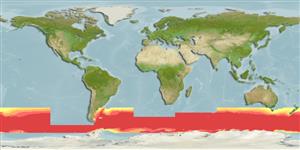Common names from other countries
Environment: milieu / climate zone / depth range / distribution range
Ecologia
marinhas batipelágico; oceanódromo (Ref. 5182); intervalo de profundidade 1 - 1008 m (Ref. 114491), usually 100 - 350 m (Ref. 4066). Deep-water; 39°S - 69°S, 180°W - 180°E (Ref. 5182)
Circumglobal between the Subtropical Convergence and Antarctic Polar Front.
Comprimento de primeira maturação / Tamanho / Peso / Idade
Maturity: Lm 8.3 range ? - ? cm
Max length : 11.2 cm SL macho/indeterminado; (Ref. 114491); 9.6 cm SL (female); peso máx. publicado: 12.10 g (Ref. 5182); peso máx. publicado: 12.10 g; idade máx. registrada: 6 anos (Ref. 31516)
Espinhos dorsais (total) : 0; Raios dorsais (total) : 13 - 15; Espinhos anais: 0; Raios anais : 18 - 20.
Oceanic and mesopelagic, found in the upper 100 m south of 50°S, but below 550 m in the region of Subtropical Convergence (Ref. 4066). Migrates from 80 to 140 m to the surface at about 18h00 with ascent rate of 0.5 m per minute; the descent rate is 1.8 m per minute. Forms the main component of the Deep Scattering Layer in the Pacific sector. Feeds on copepods, hyperiids and euphausiids, but also takes ostracods and gastropods. Eaten by squid and to an insignificant degree, by fishes (Channichthyidae, Notolepis sp.) and birds (Procellariidae).
Ciclo de vida ou comportamento de acasalamento
Maturities | Reprodução | Spawnings | Egg(s) | Fecundities | Larvas
Hulley, P.A., 1990. Myctophidae. p. 146-178. In O. Gon and P.C. Heemstra (eds.) Fishes of the Southern Ocean. J.L.B. Smith Institute of Ichthyology, Grahamstown, South Africa. (Ref. 5182)
Status na Lista Vermelha da UICN (Ref. 130435)
CITES (Ref. 128078)
Not Evaluated
Ameaça para os humanos
Harmless
Uso pelos humanos
Pescarias: espécies comerciais
Ferramentas
Relatórios especiais
Baixar XML
Fontes da internet
Estimates based on models
Preferred temperature (Ref.
115969): -1.3 - 2.4, mean 0.7 (based on 31 cells).
Índice de diversidade filogenética (Ref.
82804): PD
50 = 0.5312 [Uniqueness, from 0.5 = low to 2.0 = high].
Bayesian length-weight: a=0.00692 (0.00297 - 0.01609), b=3.13 (2.93 - 3.33), in cm Total Length, based on LWR estimates for this (Sub)family-body shape (Ref.
93245).
Nível Trófico (Ref.
69278): 3.2 ±0.0 se; based on diet studies.
Resiliência (Ref.
120179): médio(a), tempo mínimo de duplicação da população 1,4 - 4,4 anos (K=0.55; tmax=5.5).
Fishing Vulnerability (Ref.
59153): Low vulnerability (24 of 100).
